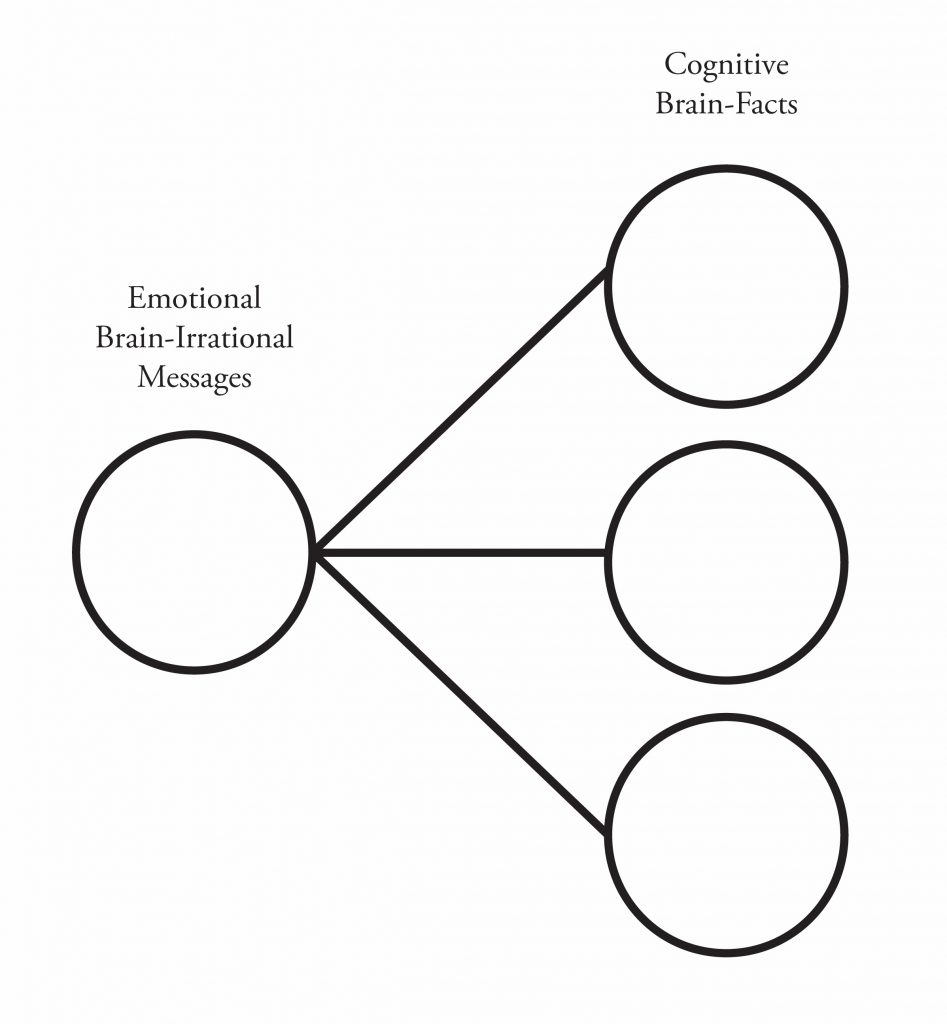This Simple Mental Trick Has Helped Thousands of HSPs Stop Emotional Overload

There are two parts in your brain: the emotional/irrational brain (limbic system) and the thinking/rational brain (cognitive brain). When your emotional brain is activated, your thinking brain basically goes to sleep. When you experience symptoms of anxiety, which activates your limbic system, your brain believes you’re in real danger. This sets up a system that prepares your brain for the flight-or-fight response.
Most highly sensitive people (HSPs) spend more time in the emotional brain than non-HSPs.
While anxiety can be a normal experience for most people, it can be elevated for an HSP. For example, our stress levels may skyrocket when we have to meet new people, go for a job interview, attend a social gathering, or go to a new school or event. Sometimes, it even happens when we’re unable to pinpoint the exact cause of our anxiety.
In my work with HSPs around the world, I have developed brain training techniques to help get us out of an activated limbic system. It’s our limbic system that usually makes us feel like we’re overwhelmed or have emotional experiences that feel out of control. Learning the difference between what the brain sees as a potential threat and what the real threat is can help us manage the brain’s false alarms.
First, let’s look at how you can identify your emotional triggers. Then, I’ll share the simple mental trick that has helped thousands of HSPs bypass emotional overload.
How to Identify Your Emotional Triggers
Managing the brain’s false alarms starts by learning to identify emotional triggers. Triggers are moments when you realize you’re “reacting” to something. You might notice a tightening in your chest or shallow breathing or an increased heart rate. Pay attention to when you notice stress levels rising, and write down the things that cause it. Maybe you feel stressed every time you’re around a particular person or when you aren’t listened to in your relationship or at work.
The common neural pathway response to stressors is to go directly to our limbic system. We experience the stress and/or trigger, and our limbic system gets activated. This happens if we do nothing, but every time we notice we’re being triggered, we begin the process of creating a new neural pathway that will allow us to bypass the automatic limbic system activation.
Most people go through three stages when creating this new pathway:
- The first stage is you sometimes notice your triggers — and sometimes you don’t.
- The second stage is you notice your triggers and know you have this choice to go on the new path or slide along the original one. And, since it’s so slippery and well-worn, you watch yourself head directly to the limbic system. That’s okay — that’s part of the process. The success is that you noticed!
- The third stage is you create this pause-and-reflect ability just before the new sprout. You notice you’re being triggered, and you practice self-care tools that help you bypass the original default pathway. The more you successfully do this, the clearer that new neural pathway becomes. Soon your sprout begins to grow, and once it grows, you get to keep it.
Here’s where we check in about our HSP perfectionist tendencies — those high expectations of ourselves that are impossible to meet. This training does not mean we always bypass our limbic systems. It means that with practice and training, we can get good at it, but we sometimes will still have it activated, especially if there’s sensory overload, if we haven’t slept enough, if we’re sick, or if we’re going through a time of extreme stress.
As with anything in life, we get better at it with practice.
The Simple Trick to Bypass Emotional Overload
Now, let’s learn the trick I developed that turns our cognitive brain back on so it can help our emotional brain out of its “funk.” Take a look at this diagram:
The circle on the left represents your emotional brain’s message, which is our irrational and false messages. The three circles on the right represent the cognitive brain, where we find rational thought, memory, and facts. Only the cognitive brain is able to come up with facts and rational messages.
When you feel overwhelmed, grab a piece of paper. Inside the circle on the left, write down the emotion you’re feeling. Then, on the right, write down cognitive facts (more on this below) in the three circles that support the emotion. The process of coming up with the words you use inside the circles will help turn your cognitive brain back online.
This is an amazing tool to use when you notice you’re activating your limbic system and becoming irrational or overwhelmed. I still practice this method in my own life, and it continues to work for me and my clients that practice it. As an HSP, you can be good at reading your internal world, so you’ll be able to notice when you’re going into your emotional brain.
The more you practice this, the sooner you can respond. When I get emotional about something, I can feel it, so I take out a piece of paper — or I have my partner remind me to do this if I forget (because in our emotional brain, we can lose access to memory).
Thinking of Facts Turns Your Cognitive Brain Back On
How do we identify the core emotions we’re feeling? This part can take time, and often, working with a good therapist can help you identify them. Most of us only have three to four main core emotional messages, and once we learn our main ones, we can better target them more successfully. These cores may be covered in many layers, and you may have a hard time identifying what they are at first, but with continued mindfulness, you will get better.
Some main core emotional messages are:
- I don’t feel safe.
- I fear abandonment.
- I fear judgment.
Let’s use the common “I’m not good enough” core as an example. Maybe you were triggered and felt bad about yourself, and then you peel off the layers and realize that what is underneath all of it is the feeling of not being good enough. Then, you can ask yourself to name three facts that counter that message.
For this example, we’ll use these facts:
- I performed well on a task (fill in your own task example).
- Other people told me I did a good job.
- Friends and family care about me and see my worth.
The act of trying to come up with facts is going to help you turn your cognitive brain back on. By using this tool to get out of your limbic system, you start to trust that you can handle any emotion you experience. Try it the next time you feel very emotional about something. Sometimes, when you first start this, it’s hard, so you may have to wait until after you’ve calmed down a bit. That’s okay. Still use the opportunity to learn by practicing this tool anyway.
Remember, if you’re hard on yourself about your emotions, this tool will be nearly impossible to create and use. So you must practice compassion for your emotions without judgment in order to allow yourself to explore your personal triggers. Only then can you begin to create a new neural sprout, gain control of your reactions, and begin living the life you were meant to live.
The world needs HSPs — it needs you! — living your best life.
Do you find our chaotic, modern world to be very challenging? As an HSP, you might feel misunderstood, have high-stress levels, and are overwhelmed a lot. Fortunately, there is a way to feel better. To learn how, check out my new eBook, The Empowered Highly Sensitive Person.
You might like:
- How I Learned to Stop Absorbing Other People’s Emotions
- 21 Signs That You’re a Highly Sensitive Person
- How to Calm Down When You Feel Crazy Stressed
- The 21 Things That Stress Out Highly Sensitive People the Most
- Why HSPs Get Mentally and Emotionally ‘Flooded’
Did you enjoy this article? Sign up for our newsletters to get more stories like this.


